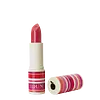What's inside
What's inside
 Key Ingredients
Key Ingredients

 Benefits
Benefits

 Concerns
Concerns

 Ingredients Side-by-side
Ingredients Side-by-side

Pentaerythrityl Tetraisostearate
EmollientPolybutene
Cera Microcristallina
Emulsion StabilisingSynthetic Wax
AbrasiveVp/Hexadecene Copolymer
Butyrospermum Parkii Butter Extract
Skin ConditioningOctyldodecanol
EmollientCaprylic/Capric Triglyceride
MaskingMica
Cosmetic ColorantSilica
AbrasiveTocopheryl Acetate
AntioxidantPolyglyceryl-2 Diisostearate
EmulsifyingPhenethyl Alcohol
MaskingCaprylyl Glycol
EmollientRubus Chamaemorus Seed Oil
Skin ConditioningCI 77891
Cosmetic ColorantCI 73360
Cosmetic ColorantCI 77492
Cosmetic ColorantCI 42090
Cosmetic ColorantPentaerythrityl Tetraisostearate, Polybutene, Cera Microcristallina, Synthetic Wax, Vp/Hexadecene Copolymer, Butyrospermum Parkii Butter Extract, Octyldodecanol, Caprylic/Capric Triglyceride, Mica, Silica, Tocopheryl Acetate, Polyglyceryl-2 Diisostearate, Phenethyl Alcohol, Caprylyl Glycol, Rubus Chamaemorus Seed Oil, CI 77891, CI 73360, CI 77492, CI 42090
Trimethylsiloxysilicate
EmollientIsohexadecane
EmollientSynthetic Wax
AbrasiveMica
Cosmetic ColorantEthylhexyl Palmitate
EmollientIsododecane
EmollientMicrocrystalline Wax
Emulsion StabilisingPolybutene
Silica
AbrasiveC13-15 Alkane
SolventVp/Hexadecene Copolymer
Paraffin
PerfumingEthylene/Propylene Copolymer
AbrasiveCopernicia Cerifera Wax
Parfum
MaskingCaprylyl Glycol
EmollientGardenia Florida Fruit Extract
Skin ConditioningGlyceryl Caprylate
EmollientHelianthus Annuus Seed Oil
EmollientNelumbo Nucifera Flower Extract
Skin ConditioningNymphaea Odorata Root Extract
RefreshingLinalool
PerfumingTitanium Dioxide
Cosmetic ColorantCI 42090
Cosmetic ColorantIron Oxides
CI 15850
Cosmetic ColorantTrimethylsiloxysilicate, Isohexadecane, Synthetic Wax, Mica, Ethylhexyl Palmitate, Isododecane, Microcrystalline Wax, Polybutene, Silica, C13-15 Alkane, Vp/Hexadecene Copolymer, Paraffin, Ethylene/Propylene Copolymer, Copernicia Cerifera Wax, Parfum, Caprylyl Glycol, Gardenia Florida Fruit Extract, Glyceryl Caprylate, Helianthus Annuus Seed Oil, Nelumbo Nucifera Flower Extract, Nymphaea Odorata Root Extract, Linalool, Titanium Dioxide, CI 42090, Iron Oxides, CI 15850
 Reviews
Reviews

Ingredients Explained
These ingredients are found in both products.
Ingredients higher up in an ingredient list are typically present in a larger amount.
Caprylyl Glycol is a humectant and emollient, meaning it attracts and preserves moisture.
It is a common ingredient in many products, especially those designed to hydrate skin. The primary benefits are retaining moisture, skin softening, and promoting a healthy skin barrier.
Though Caprylyl Glycol is an alcohol derived from fatty acids, it is not the kind that can dry out skin.
This ingredient is also used as a preservative to extend the life of products. It has slight antimicrobial properties.
Learn more about Caprylyl GlycolCi 42090 is a synthetic dye created from petroleum. It is used to give a bright blue color to cosmetics, medicine, and food.
Mica is a naturally occurring mineral used to add shimmer and color in cosmetics. It can also help improve the texture of a product or give it an opaque, white/silver color.
Serecite is the name for very fine but ragged grains of mica.
This ingredient is often coated with metal oxides like titanium dioxide. Trace amounts of heavy metals may be found in mica, but these metals are not harmful in our personal products.
Mica has been used since prehistoric times throughout the world. Ancient Egyptian, Indian, Greek, Roman, Aztec, and Chinese civilizations have used mica.
Learn more about MicaPolybutene is used to help control the viscosity of a product. This just means it helps adjusts the texture.
It is a polymer and does not get absorbed into the skin due to its large size.
Studies found this ingredient did not irritate skin in concentrations below 15%.
Learn more about PolybuteneSilica, also known as silicon dioxide, is a naturally occurring mineral. It is used as a fine, spherical, and porous powder in cosmetics.
Though it has exfoliant properties, the function of silica varies depending on the product.
The unique structure of silica enhances the spreadability and adds smoothness, making it a great texture enhancer.
It is also used as an active carrier, emulsifier, and mattifier due to its ability to absorb excess oil.
In some products, tiny microneedles called spicules are made from silica or hydrolyzed sponge. When you rub them in, they lightly polish away dead skin layers and enhance the penetration of active ingredients.
Learn more about SilicaSynthetic Wax is created from fossil fuels such as natural gas. It is used to enhance texture, adjust pH, and as an occlusive.
It may also be used as an abrasive ingredient to exfoliate the skin.
Synthetic Wax may not be fungal acne safe.
Learn more about Synthetic WaxVP/Hexadecene Copolymer is a synthetic film-forming agent. It has both water and oil loving properties, allowing it to create a flexible, even film on the skin.
This ingredient helps enhance texture, smoothness, and wear resistance in makeup products while reducing tackiness.